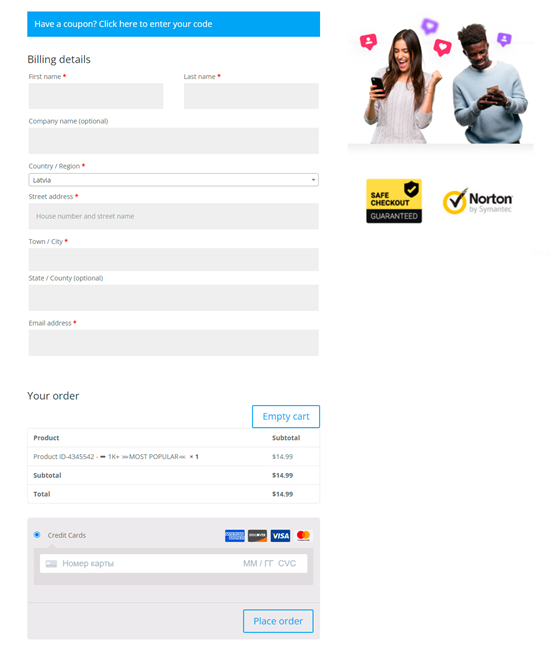Summary
Client had trouble managing orders across multiple WooCommerce websites.
2410 built a dual-plugin system to automate and centralize order processing.
The client now processes all orders from one site, saving time and improving efficiency.
Client story
Social MediaGram, a digital service provider for social media growth, managed several independent WooCommerce websites tailored to different audience segments. Each site allowed users to choose and purchase specific services, but handling orders separately on each platform became inefficient.
The goal was to simplify operations by centralizing order processing to a single main site. However, standard WooCommerce plugins - free or premium - couldn’t support this need. Frustrated by the limitations, the client turned to 2410, who developed a solution that not only solved the issue but laid a scalable foundation for future growth.
Project overview
2410 developed a tailored WooCommerce integration to synchronize order data across multiple WordPress websites. The project was initiated to bridge the gap between separate storefronts, allowing users to interact with various service sites, while all data and payments were processed centrally.
The dual-plugin setup consisted of a sender plugin on Site 1 and a receiver on Site 2. Custom checkout data was invisibly passed from the initial storefront to the processing site, where it triggered manual or automated API requests based on admin-configured mappings.
The system was built with flexibility in mind. Products with multiple variations and complex data fields were fully supported. 2410 also implemented a reusable admin UI for mapping API fields per product. Additional features included webhook support, hosting environment testing, and performance benchmarking to recommend optimal setups.
The result is a scalable, reusable solution for any multi-site WooCommerce setup looking to streamline order automation, reduce redundancy, and increase control over third-party integrations.
- Arturs, Yarina (SocialMediaGram)
Key features delivered
- Two custom WordPress plugins: Data Exchange OUT and API Sync
- Cross-site data synchronization between WooCommerce checkouts
- Dynamic admin interface for API field mapping
- Support for manual and automated API requests
- Webhook integration for order events
- Compatibility with multiple Site 1 instances
- Performance testing and hosting optimization recommendations
Technology stack
The result
Streamlined Plugin Setup
By implementing a custom WooCommerce automation solution, 2410 eliminated the need for redundant plugin setups and manual processes across multiple WordPress stores. The client now operates with a streamlined, centralized workflow that has greatly improved efficiency.
One Central Point of Processing
Instead of configuring payment systems, integrations, and order management tools on each separate domain, all operations now flow through a single optimized environment — the main site.
Tip: This approach is ideal for multi-store WooCommerce setups that need centralized checkout and automated order processing.
Automated Order Flow
Orders placed on any satellite site are automatically:
- Collected via a custom plugin that captures WooCommerce custom fields
- Transferred to the main domain in the background
- Processed on the centralized backend
Operational Benefits
This solution not only cut operational overhead, but also enabled faster processing times, better API integrations, and simplified team workflows — all while following best practices in WordPress plugin development.
Key benefits:
- Reduced maintenance across sites
- Single point of order tracking and customer support
- Improved checkout UX with hidden background logic
- Scalable setup for adding more storefronts

Product selection with custom fields
WooCommerce product page with custom input fields

WooCommerce checkout page
Checkout page showing seamless data transfer
Note: All plugins were developed to be reusable across different domains, making the solution future-proof and cost-effective.
In short, the custom dual-plugin system by 2410 transformed a complex, multi-site ordering system into a clean, efficient, and scalable WooCommerce architecture — perfect for growing e-commerce businesses.
Thinking about building a similar system?
Below are common questions from clients who are considering a custom WordPress/WooCommerce integration like the one described in this case study. These questions focus on how such a solution works, what to expect, and how flexible it can be for your business.
Yes. The plugin system can be scaled to collect data from multiple WordPress sites and send it to a central processing site. The architecture is designed to handle multi-site environments, and each new site can be added with minimal configuration.
No. The transition is seamless and invisible to users. All custom field data is collected silently on the first site and passed to the second site during the checkout process, without requiring the customer to re-enter any information.
Absolutely. The system was built to support product variations, custom fields, and multiple configurations. You’ll have full flexibility to define services, fields, and even API behavior per product or variation.
Yes. The system allows both manual and automatic API order submission. You can configure products to queue orders for admin review or send them automatically once payment is confirmed.
We build the admin panel to let you map fields per product. If your external API structure changes, you can re-map the necessary fields in the interface - no need for code changes. This makes the system flexible for long-term use.
Yes, the plugins are modular and made for reuse. As long as the site structure is similar, you can install the same plugins and manage them through simple configurations.
We test the system across various hosting platforms and provide recommendations for optimal performance. If you change hosts, the system should still work, and we can assist with any migration steps if needed.